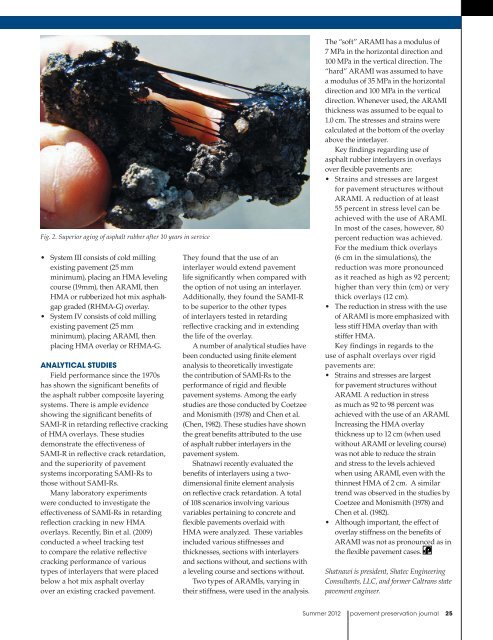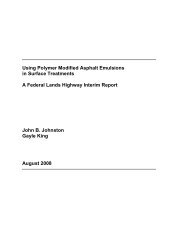journal - TSP2
journal - TSP2
journal - TSP2
You also want an ePaper? Increase the reach of your titles
YUMPU automatically turns print PDFs into web optimized ePapers that Google loves.
Fig. 2. Superior aging of asphalt rubber after 10 years in service<br />
• System III consists of cold milling<br />
existing pavement (25 mm<br />
minimum), placing an HMA leveling<br />
course (19mm), then ARAMI, then<br />
HMA or rubberized hot mix asphaltgap<br />
graded (RHMA-G) overlay.<br />
• System IV consists of cold milling<br />
existing pavement (25 mm<br />
minimum), placing ARAMI, then<br />
placing HMA overlay or RHMA-G.<br />
ANALYTICAL STUDIES<br />
Field performance since the 1970s<br />
has shown the significant benefits of<br />
the asphalt rubber composite layering<br />
systems. There is ample evidence<br />
showing the significant benefits of<br />
SAMI-R in retarding reflective cracking<br />
of HMA overlays. These studies<br />
demonstrate the effectiveness of<br />
SAMI-R in reflective crack retardation,<br />
and the superiority of pavement<br />
systems incorporating SAMI-Rs to<br />
those without SAMI-Rs.<br />
Many laboratory experiments<br />
were conducted to investigate the<br />
effectiveness of SAMI-Rs in retarding<br />
reflection cracking in new HMA<br />
overlays. Recently, Bin et al. (2009)<br />
conducted a wheel tracking test<br />
to compare the relative reflective<br />
cracking performance of various<br />
types of interlayers that were placed<br />
below a hot mix asphalt overlay<br />
over an existing cracked pavement.<br />
They found that the use of an<br />
interlayer would extend pavement<br />
life significantly when compared with<br />
the option of not using an interlayer.<br />
Additionally, they found the SAMI-R<br />
to be superior to the other types<br />
of interlayers tested in retarding<br />
reflective cracking and in extending<br />
the life of the overlay.<br />
A number of analytical studies have<br />
been conducted using finite element<br />
analysis to theoretically investigate<br />
the contribution of SAMI-Rs to the<br />
performance of rigid and flexible<br />
pavement systems. Among the early<br />
studies are those conducted by Coetzee<br />
and Monismith (1978) and Chen et al.<br />
(Chen, 1982). These studies have shown<br />
the great benefits attributed to the use<br />
of asphalt rubber interlayers in the<br />
pavement system.<br />
Shatnawi recently evaluated the<br />
benefits of interlayers using a twodimensional<br />
finite element analysis<br />
on reflective crack retardation. A total<br />
of 108 scenarios involving various<br />
variables pertaining to concrete and<br />
flexible pavements overlaid with<br />
HMA were analyzed. These variables<br />
included various stiffnesses and<br />
thicknesses, sections with interlayers<br />
and sections without, and sections with<br />
a leveling course and sections without.<br />
Two types of ARAMIs, varying in<br />
their stiffness, were used in the analysis.<br />
The “soft” ARAMI has a modulus of<br />
7 MPa in the horizontal direction and<br />
100 MPa in the vertical direction. The<br />
“hard” ARAMI was assumed to have<br />
a modulus of 35 MPa in the horizontal<br />
direction and 100 MPa in the vertical<br />
direction. Whenever used, the ARAMI<br />
thickness was assumed to be equal to<br />
1.0 cm. The stresses and strains were<br />
calculated at the bottom of the overlay<br />
above the interlayer.<br />
Key findings regarding use of<br />
asphalt rubber interlayers in overlays<br />
over flexible pavements are:<br />
• Strains and stresses are largest<br />
for pavement structures without<br />
ARAMI. A reduction of at least<br />
55 percent in stress level can be<br />
achieved with the use of ARAMI.<br />
In most of the cases, however, 80<br />
percent reduction was achieved.<br />
For the medium thick overlays<br />
(6 cm in the simulations), the<br />
reduction was more pronounced<br />
as it reached as high as 92 percent;<br />
higher than very thin (cm) or very<br />
thick overlays (12 cm).<br />
• The reduction in stress with the use<br />
of ARAMI is more emphasized with<br />
less stiff HMA overlay than with<br />
stiffer HMA.<br />
Key findings in regards to the<br />
use of asphalt overlays over rigid<br />
pavements are:<br />
• Strains and stresses are largest<br />
for pavement structures without<br />
ARAMI. A reduction in stress<br />
as much as 92 to 98 percent was<br />
achieved with the use of an ARAMI.<br />
Increasing the HMA overlay<br />
thickness up to 12 cm (when used<br />
without ARAMI or leveling course)<br />
was not able to reduce the strain<br />
and stress to the levels achieved<br />
when using ARAMI, even with the<br />
thinnest HMA of 2 cm. A similar<br />
trend was observed in the studies by<br />
Coetzee and Monismith (1978) and<br />
Chen et al. (1982).<br />
• Although important, the effect of<br />
overlay stiffness on the benefits of<br />
ARAMI was not as pronounced as in<br />
the flexible pavement cases.<br />
Shatnawi is president, Shatec Engineering<br />
Consultants, LLC, and former Caltrans state<br />
pavement engineer.<br />
Summer 2012 pavement preservation <strong>journal</strong> 25
















